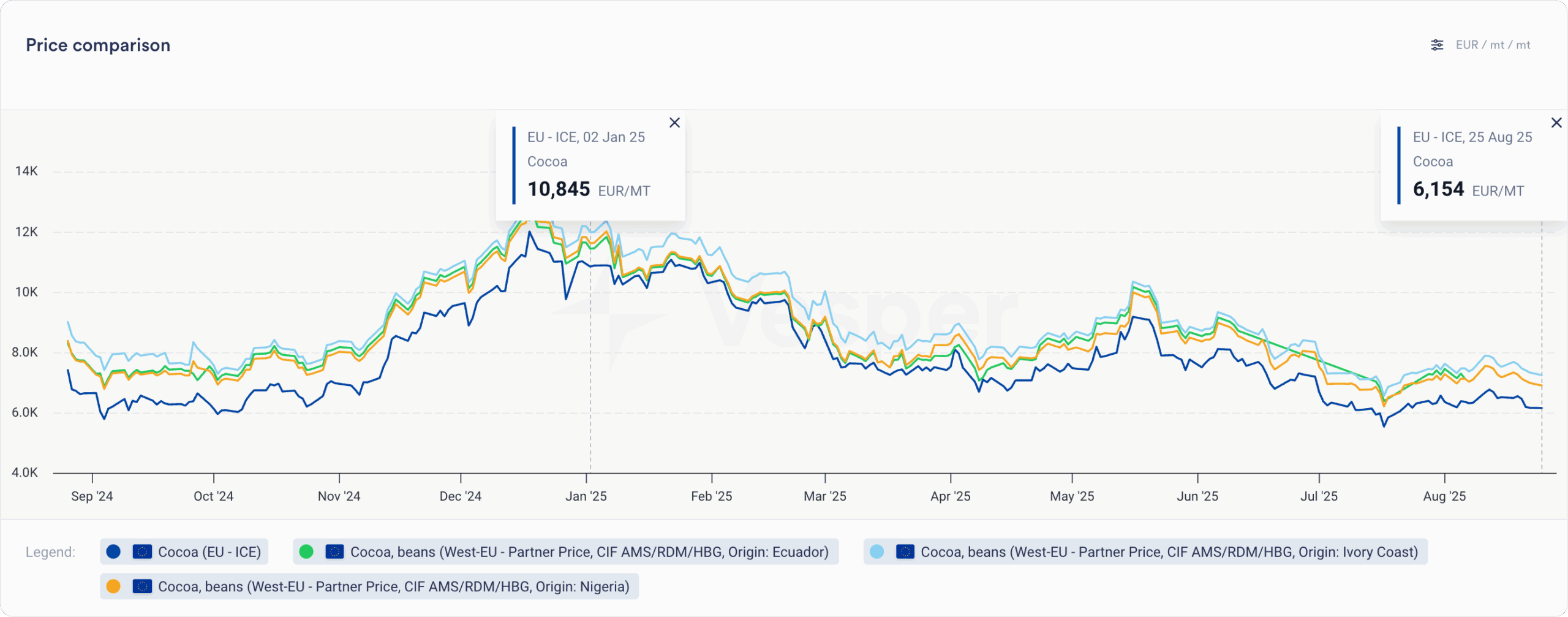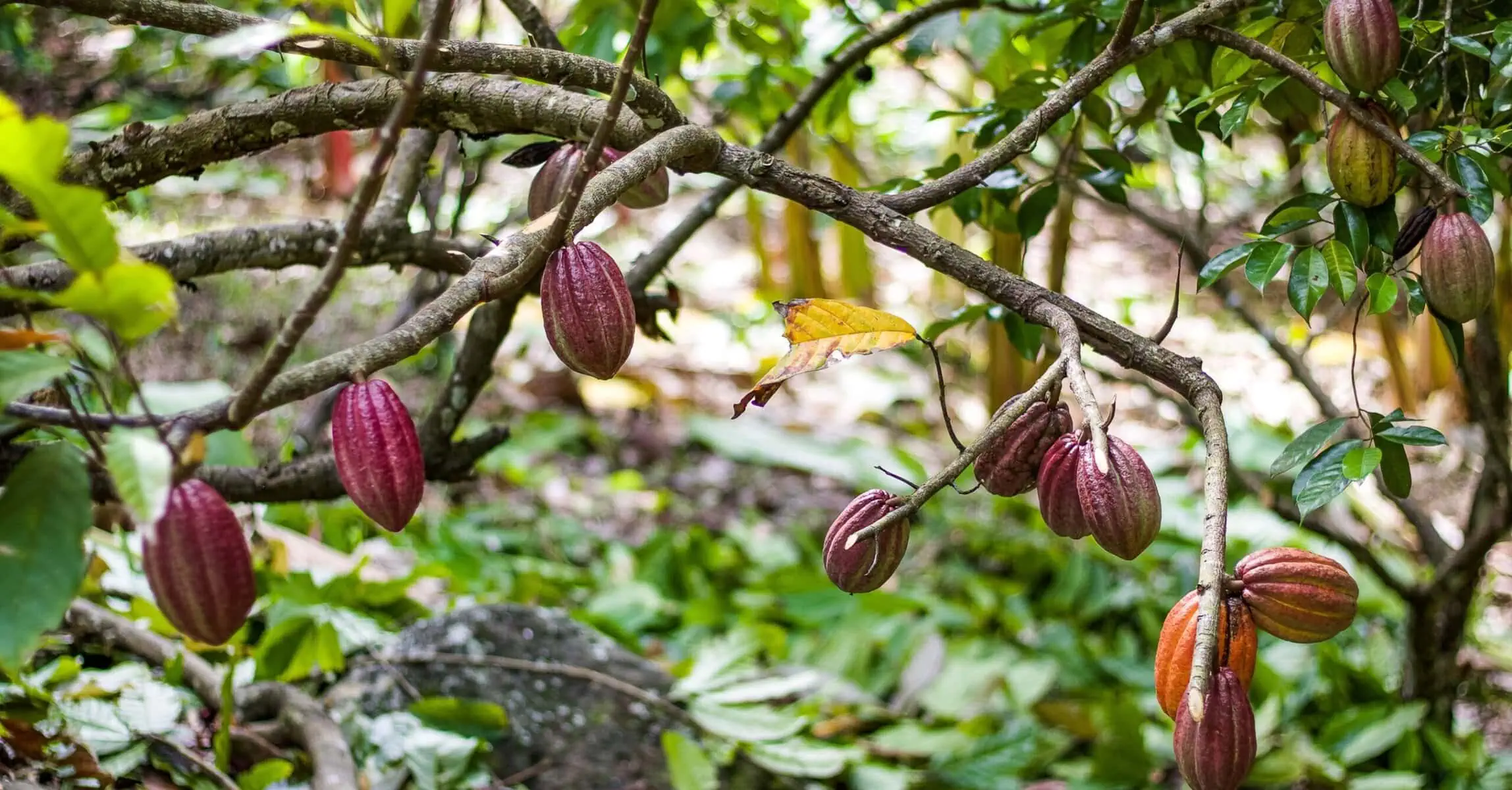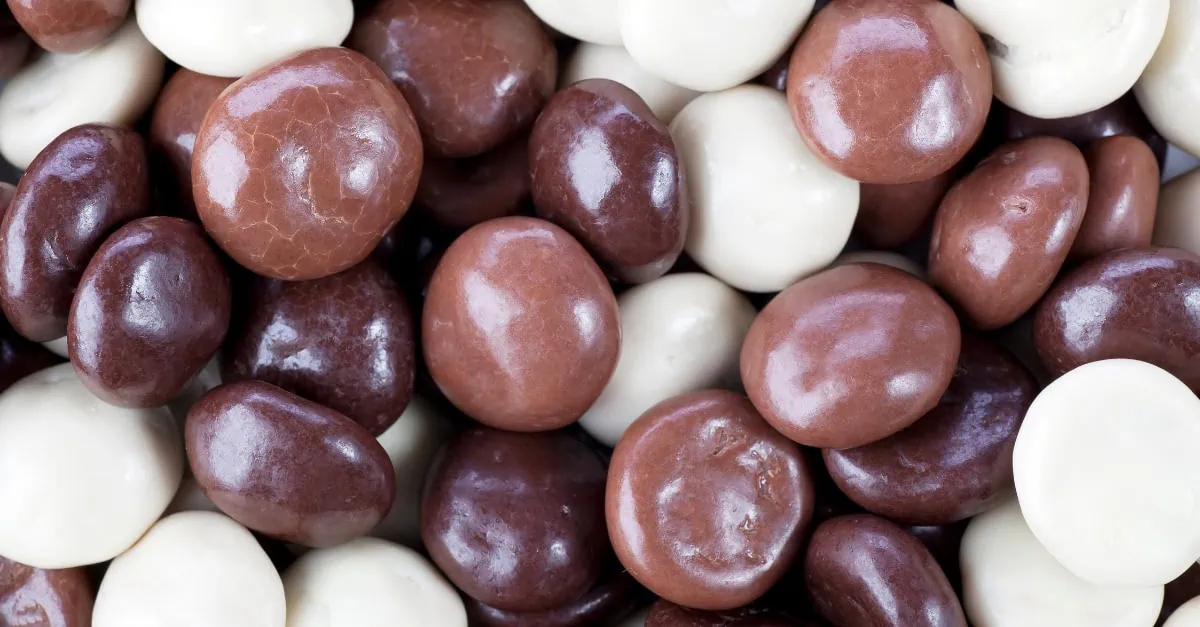After reaching unprecedented levels at the end of 2024, cocoa prices experienced a dramatic 43% decline throughout 2025, falling from over €10,800 per metric ton to approximately €6,150 by August. Unlike typical commodity corrections driven by supply recovery, this crash was fueled by demand destruction and structural industry changes that fundamentally altered chocolate consumption patterns.

The timeline below offers a clear month-by-month breakdown of price trends, key market events, and major drivers behind this historic correction. This comprehensive review helps traders, buyers, and industry stakeholders understand not just what happened, but why cocoa collapsed from record highs – and what this means for the future of chocolate procurement globally.
January 2025: Peak volatility
The year began with cocoa futures at their most volatile, with ICE London futures having gained £5,333 (157.8%) throughout 2024, while New York futures surged $6,878 (165.3%). Daily trading ranges reached what market veterans described as “insane” levels, with single-day moves exceeding £900 in London and $1,161 in New York.
The extreme prices were supported by multiple supply crises:
- Three consecutive cocoa bean deficits
- Record low stocks in exchange warehouses at just 25,520 mt in London
- A 46-year low global stock-to-grind ratio of 27%
- Structural supply problems in Ivory Coast and Ghana
- Swollen shoot virus affecting 67% of West African farms
- Smuggling losses estimated at 50-100k mt annually from Ivory Coast
However, the first cracks began to show. Managed Money held a massive 68,400 contracts long position as of December 24th, but their behavior became increasingly erratic. The chocolate industry’s futures price cover remained at historically low levels of around 5 months.
Early demand destruction signals emerged:
- Barry Callebaut reported global chocolate sales down 4.7%
- Cocoa processing volumes declined 5.6%
- Chocolate manufacturers began aggressive cost management strategies
- Consumer prices for chocolate products started rising dramatically
February 2025: Price correction begins
February marked the beginning of cocoa’s correction as multiple negative factors converged. Managed Money started liquidating their historically large positions, recognizing that the market had become disconnected from sustainable levels.
Weather conditions showed improvement:
- Better rainfall patterns emerged in West Africa
- Harsh Harmattan winds subsided
- Early pod development appeared more normal than previous year
Demand destruction became undeniable:
- Ivory Coast’s cocoa grind fell 4.7% year-over-year to 52,461 mt
- Total grinding from October-February down 0.3% vs. previous season
- GEPEX data showed processors struggling with high costs
- Reduced demand from chocolate manufacturers became evident
Market structure began shifting:
- Exchange bean stocks started recovering from 21-year lows
- New York stocks increased to 1.38 million bags from January low of 1.29 million
- Psychological shift away from crisis-level inventory helped ease panic buying
- Traditional forward hedging patterns began breaking down
March 2025: Managed Money exodus accelerates
March saw the most dramatic Managed Money liquidation in cocoa market history. The combined net speculative position decreased by 25,700 lots to just 33,500 lots long – the lowest level since May 2024.
Multiple factors drove the liquidation:
- Improving weather conditions in West Africa continued
- Macro uncertainty related to global trade policies
- Mounting evidence of permanent demand destruction
- Financing costs for commodity positions soared
Supply situation showed signs of stabilization:
- Cocoa arrivals in Ivory Coast reached 1.368 million mt by February 23rd
- This represented a 17.6% increase from same period previous season
- Supply crisis appeared to be moderating
- Quality issues remained but volumes improved
Q1 grinding data confirmed demand destruction:
- European grinding: -3.7% to 353,522 mt
- North American grinding: -2.5% to 110,278 mt
- Asian grinding: -3.5% to 213,898 mt
- Combined reportable grind: -3.5%
Chocolate manufacturers implemented cost strategies:
- Nestle announced minimal price pass-through policy
- Gross profit margins declined from 47.2% to 46.3%
- Reformulation strategies accelerated
- Package size optimization began
April-May 2025: Demand destruction
The second quarter delivered crushing evidence of demand destruction across all major cocoa-consuming regions, with grinding data showing the steepest declines since the COVID pandemic.
European market showed severe stress:
- Q2 grinding plummeted 7.2% year-over-year to 331,762 mt
- This marked a five-year low
- Steepest decline since early COVID pandemic
- Processing capacity utilization fell significantly
Asian markets faced even worse declines:
- Asian grinding fell 16.3% to 176,644 mt (lowest since 2017)
- Malaysian grinding dropped 22% to 70,196 mt
- These represented fundamental changes in manufacturing patterns
- Regional supply chains began restructuring
Major chocolate companies reported dramatic volume losses:
- Hershey: 18% decline in volume/mix with only 3% price increases
- Result: 15.2% decline in net sales
- Mondelez: chocolate volumes down 5.7% despite 10.1% price increases
- CEO warned consumers to expect 30-50% higher chocolate prices
Industry adaptation accelerated:
- “Double-digit price increases” became standard across the industry
- Shrinkflation strategies implemented widely
- Non-chocolate product lines promoted more heavily
- Supply chain financing challenges intensified
Supply-side developments provided some relief:
- Ivory Coast’s mid-crop arrivals improved (though quality remained poor)
- Pod counters reported better conditions for 2025/26 main crop
- Long-term concerns about swollen shoot virus persisted
- Aging plantation issues remained unresolved
June-July 2025: Weather market
The traditional “silly season” weather market began with initial optimism about West African crop development, but the focus had permanently shifted to industry structural changes.
Weather and crop outlook improved:
- Rainfall data showed improvement across key growing regions
- Early pod counts suggested more normal crop development
- 2025/26 season forecasts became cautiously optimistic
- Market participants remained wary given recent disappointments
Industry transformation accelerated:
- Barry Callebaut cut annual sales volume guidance for second time
- Now expecting 7% decline in full-year volumes
- Global chocolate business saw 12.3% Q3 volume decline in North America
- Company described it as “largest decline in a decade”
Product reformulation became widespread:
- Manufacturers increased use of fillers, nuts, and non-cocoa ingredients
- Nestle announced techniques to use 30% more of cocoa fruit
- This included previously discarded pulp and pod components
- Innovation focused on maintaining taste with less cocoa content
Alternative ingredients gained traction:
- AAK reported 29% year-over-year growth in cocoa butter equivalents
- Vegetable oils increasingly substituted for expensive cocoa butter
- Carob powder emerged as chocolate alternative
- Wheat-based cocoa powder substitutes entered development
Market structure changes deepened:
- Traditional 18-month forward hedging collapsed to 4-5 months maximum
- Financing costs made long-term positions uneconomical
- Margin requirements soared across the supply chain
- Open Interest fell to 20-year lows
Regulatory challenges added complexity:
- Ivory Coast limited forward sales to 1.3 million mt vs. usual 1.7 million mt
- Ghana struggled with continued smuggling issues
- EU Deforestation Regulation implementation added compliance costs
- US tariff uncertainties created additional volatility
August 2025: Drought concerns
August brought new weather concerns as Ivory Coast experienced its driest 30-day period in 46 years for that time of year. However, the market’s response was more measured, reflecting reduced speculative participation and structurally lower demand.
Weather challenges returned:
- Ivory Coast faced acute dry spell at critical crop development time
- 30-day period through August 15th was driest in 46 years for that time
- Pod retention and development faced potential stress
- Next three months remained crucial for 2025/26 crop
Demand destruction data became stark:
- European Nielsen data showed dramatic volume declines
- 52-week chocolate sales values up 8.2%, but unit volumes down 4.6%
- Most recent 4-week period: volumes down 19.4%
- Average prices increased 13.4% annually
- Clear evidence of successful cost pass-through at expense of volume
Processing industry adapted to new reality:
- Ivory Coast’s July grinding fell 31.2% year-over-year to 39,301 mt
- Processors cited poor bean quality and deliberately reduced purchases
- Squeezed margins forced capacity reduction strategies
- Total October-July grind down 4% from previous season
Supply chain financing remained challenging:
- Working capital requirements doubled due to higher bean values
- Margin call financing created additional costs
- Traditional commodity financing models under stress
- Banks required higher collateral for cocoa-related lending
The new market reality
The cocoa market had undergone a structural transformation. Prices remain 160% higher than pre-crisis levels of 2022, but the industry had adapted through permanent demand destruction rather than supply recovery.
Key structural changes included:
- Grinding capacity utilization permanently reduced
- Chocolate recipes reformulated with lower cocoa content
- Consumer acceptance of higher retail prices and smaller package sizes
- Supply chain regionalization away from West African dependence
- Speculative participation reduced to 20-year lows
- Traditional forward hedging practices abandoned
For procurement managers, the new reality meant:
- Opportunity to rebuild inventory coverage at lower prices
- Understanding that the industry had fundamentally changed
- Need for strategies adapted to structurally higher price levels
- Recognition that demand patterns had permanently shifted
The correction revealed systemic weaknesses:
- Ivory Coast and Ghana’s forward-selling model proved unsuitable for extreme volatility
- Farmers in regulated markets missed windfall from record prices
- Buying organizations faced massive margin calls and financing challenges
- Traditional risk management tools proved inadequate
Looking ahead, the market faces:
- Structurally higher prices despite the 43% correction
- Permanently reduced cocoa intensity in chocolate products
- An industry that learned to operate profitably with less raw material
- New equilibrium between supply constraints and demand management
The 43% decline marked not just a price correction, but the chocolate industry’s successful adaptation to a new era of cocoa scarcity. This transformation suggests that even if cocoa supplies recover, the industry’s reduced dependence on the commodity represents a permanent shift in global chocolate manufacturing and consumption patterns.
See live cocoa prices and market drivers in real time here: https://app.vespertool.com/



